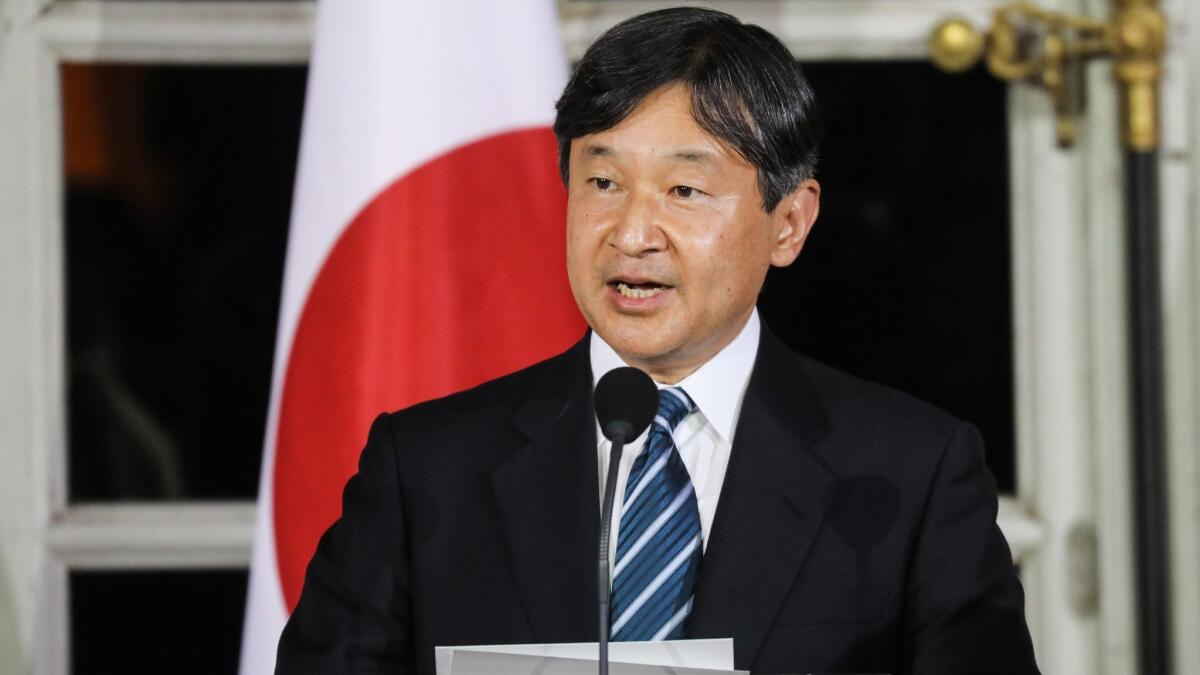Emperor Akihito, credited with bringing Japan’s monarchy closer to the people, prepares to step down

- Share via
Reporting from Tokyo — On Tuesday, Japan’s 85-year-old Emperor Akihito was scheduled to end his reign and hand the seat of the longest-running monarchy in the world to his son, Crown Prince Naruhito.
He’s the first Japanese monarch to abdicate in more than two centuries.
That seems fitting, because much about his three-decade reign was unprecedented. He was the first emperor to ascend to the Chrysanthemum Throne after the position was stripped of all political power and divinity in the new constitution that Japan adopted after its defeat in World War II.
In carving out a new, symbolic role for the emperor, Akihito brought the monarchy closer to the people, a sharp departure from the aloof and reclusive rule of his father in a country in which emperors were once worshiped as gods.
A few years after Akihito took the throne, he got down on his knees to be at eye level with disaster victims. The Japanese public was stunned.
Then it happened again and again, at the site of natural disaster after natural disaster, molding a new image of the 2,500-year-old imperial household.
In the run-up to the abdication, breathless news coverage has repeatedly shown the emperor and his wife kneeling before survivors of earthquakes or volcanic eruptions, listening and gently nodding.
“Akihito went out and was among these people,” said Ken Ruoff, a Japanese historian and director of the Center for Japanese Studies at Portland State University. “The distance between them and the people was reduced significantly compared to the previous emperor.”
Many credit his wife, Empress Michiko, for leading the couple’s approach in interacting with the Japanese people. Their marriage in 1959 after they met playing tennis caused a stir because she was a commoner, which was unprecedented.
The emperor and empress have championed the rights of the disabled and other disadvantaged segments of Japanese society.
Akihito has been a far different emperor than his father, Hirohito, who reigned for six decades, including through World War II, which Japan waged in his name.
The constitution at the time of the war gave Hirohito supreme authority, though historians continue to debate how much direct command he had over the Japanese military. It was Hirohito who accepted the terms of the surrender and announced it to the Japanese people in a radio address.
The postwar constitution shaped by U.S. Gen. Douglas MacArthur left the monarchy intact but relegated to a strictly symbolic capacity with no political authority.
Akihito became emperor after Hirohito’s death in 1989. Each emperor demarcates his reign by declaring a new era, and Akihito’s was the era of Heisei — “achieving peace.”
He directly addressed and apologized for Japan’s atrocities in the 20th century in ways his father never had, expressing “deepest regret” and acknowledging “great suffering” inflicted by Japanese troops.
The emperor’s efforts at atonement have been at odds with Japan’s right-wing conservatives, including Prime Minister Shinzo Abe, who have increasingly sought to justify Japan’s actions and see no need for apology.
“It gives me deep comfort that the Heisei era is coming to an end, free of war in Japan,” Akihito said in remarks for his 85th birthday last year.
His abdication brings that era to an end and heralds the start of a new one: Reiwa, or “beautiful harmony.”
Because there wasn’t a provision in Japan’s imperial household law allowing for the emperor to step down, the Japanese parliament had to pass a law enabling a one-time exception.
The emperor indicated his desire to abdicate in 2016, after having undergone surgeries, including for prostate cancer.
“I am worried that it may become difficult for me to carry out my duties as the symbol of the state with my whole being as I have done until now,” he said at the time.
Akihito noted that the passing of a reigning emperor required various funeral rites and a period of heavy mourning, which he said would place “a very heavy strain” on the country and his surviving family.
“The emperor’s public announcement to express a desire to abdicate while he was alive, that was his last really courageous efforts to change the role of the imperial household,” said Noriko Kawamura, a history professor at Washington State University and author of a book on Hirohito.
Akihito is expected to leave the throne in a simple 10-minute ceremony Tuesday afternoon.
His eldest son, Naruhito, 59, will become emperor the following morning, the 126th monarch in the dynasty that began in 660 BC. He is an Oxford-educated viola player married to a former diplomat, soon-to-be Empress Masako.
The couple has a daughter, 17-year-old Aiko. Because current imperial laws don’t allow female monarchs, next in line to the throne are Naruhito’s brother, Prince Akishino, followed by Akishino’s son, 12-year-old Hisahito.
Women of the imperial household are also barred by tradition from attending this week’s ceremonies, in which Naruhito will inherit the imperial regalia — a sword and jewel.
The new emperor is expected to receive President Trump as his first foreign guest in late May.

More to Read
Sign up for Essential California
The most important California stories and recommendations in your inbox every morning.
You may occasionally receive promotional content from the Los Angeles Times.











